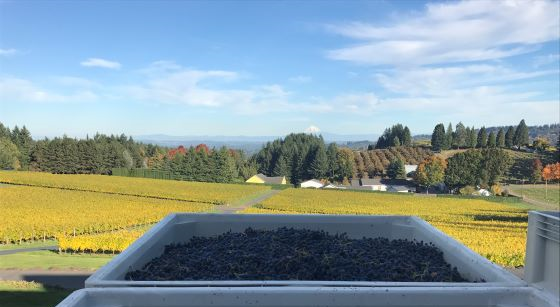Explore Oregon Wines: Wineries | Varietals | AVAs | Cellar 503 Selections
Big on Bordeaux
March 2025
With a recent total annual sales value estimated at more than €4 billion (Vins de Bordeaux, 2018) and great interest from foreign investors, the Bordeaux region has a reputation for its quality and credibility in wine production. One that producers around the world have driven themselves to emulate and (daresay!) enhance. The craze for Bordeaux grape varieties stems from their ability to produce world-renowned, complex, and age-worthy wines, achieved through unique blends and terroir-driven winemaking practices.
Raising Bordeaux's Bar
The grape varieties that rocketed France’s Bordeaux region to the top of the global heap in fine wine have been building an increasingly impressive place among Oregon’s wine offerings.
In Bordeaux, six red varietals are allowed under French regulations: Cabernet Sauvignon, Merlot, Cabernet Franc, Petit Verdot, Malbec and Carménère.
The first two were embraced early on in California and, since the American wine industry chose to market its best wines by varietal names, they have become far and away the most widely known and accepted.
Cabernet Sauvignon and Merlot: These are the flagship red grape varieties of Bordeaux, known for their ability to produce wines with rich flavors, structure, and aging potential.
Cabernet Sauvignon: Known for its dark fruit, herbal notes, and high tannins, it's a key component of Left Bank Bordeaux wines.
Merlot: Adds softness, fruitiness, and a plush texture to blends, and is dominant on the Right Bank.
The third, Cabernet Franc, has come onto the scene more recently. But, being blends, most Bordeaux wines use Cabernet Franc in a supporting role. Petit Verdot, Malbec and Carménère may or may not be members of the cast depending on winemaker preferences.
What most people don't know is...As of July 2019, Bordeaux wineries authorized the use of four new red grapes to combat effects of climate change on viticulture in Bordeaux, though only for those wines designated as Bordeaux or Bordeaux Supérior. These newly approved grapes are Marselan, Touriga Nacional, Castets, and Arinarnoa.
On the white side of things, White Bordeaux is predominantly, and exclusively in the case of the sweet Sauternes, made from Sémillon, Sauvignon blanc and Muscadelle. As with the reds, white Bordeaux wines are usually blends as well, most commonly of Sémillon and a smaller proportion of Sauvignon Blanc. Other permitted grape varieties are Sauvignon Gris, Ugni Blanc, Colombard, Merlot Blanc, Ondenc and Mauzac.
Again, what most people don't know is...As of July 2019, Bordeaux wineries authorized the use of three new white grapes: Alvarinho, Petit Manseng, and Liliorila.
There is a myriad of factors that contribute to the value and quality of wine. Out of the five most expensive red Bordeaux wines, four are from Pomerol. The small, deep clay appellation on the right bank that cultivates mainly 100% Merlot wines. At the very top of the industry is Petrus, which is not a chateau. It’s just called Petrus, not Chateau Petrus, and it sells for about $4,500 a bottle on average. But to put this in context, this same region makes a huge volume of inexpensive red wine using standard winemaking processes, which include mechanical harvesting and ageing the wine for a short time in stainless tanks. Regardless of where the wine was made - the best wines are always a small percentage of the overall production. Great wines are made where a great deal of attention is paid both in the vineyard and the winery to achieve outstanding results. Small lot expressions were built to shine in this light.
We hope you'll join us in raising a glass to the old varieties and new. Raise your glass with us in honor of the fearless producers that are always looking to raise that bar, paying no heed to the levels of accolade that have come before them.




